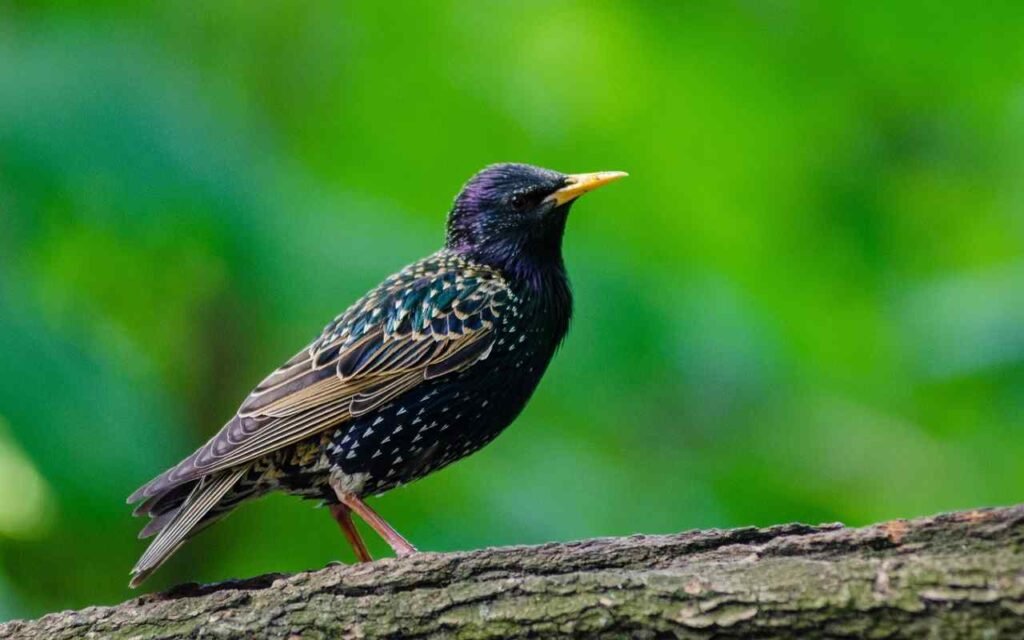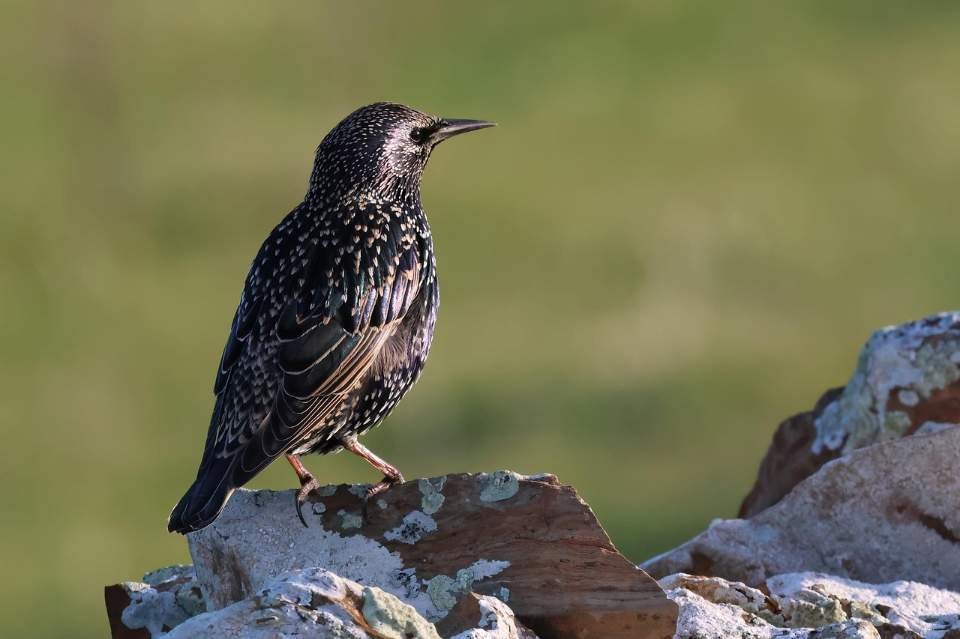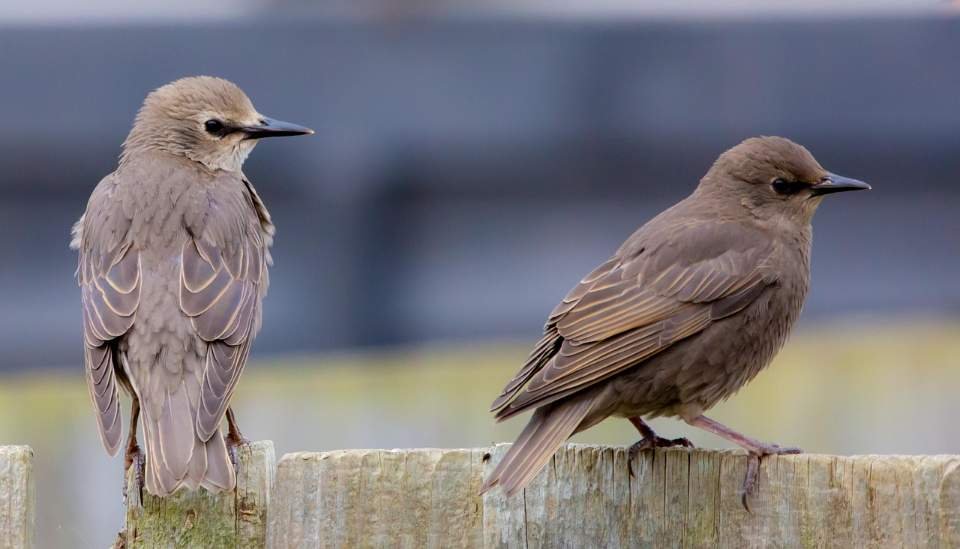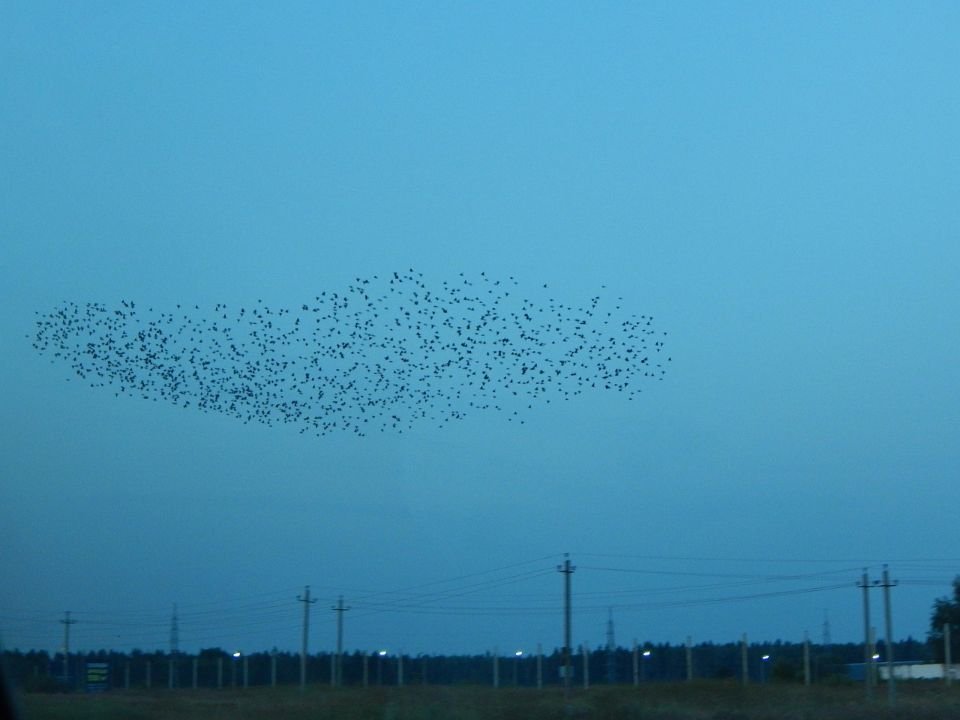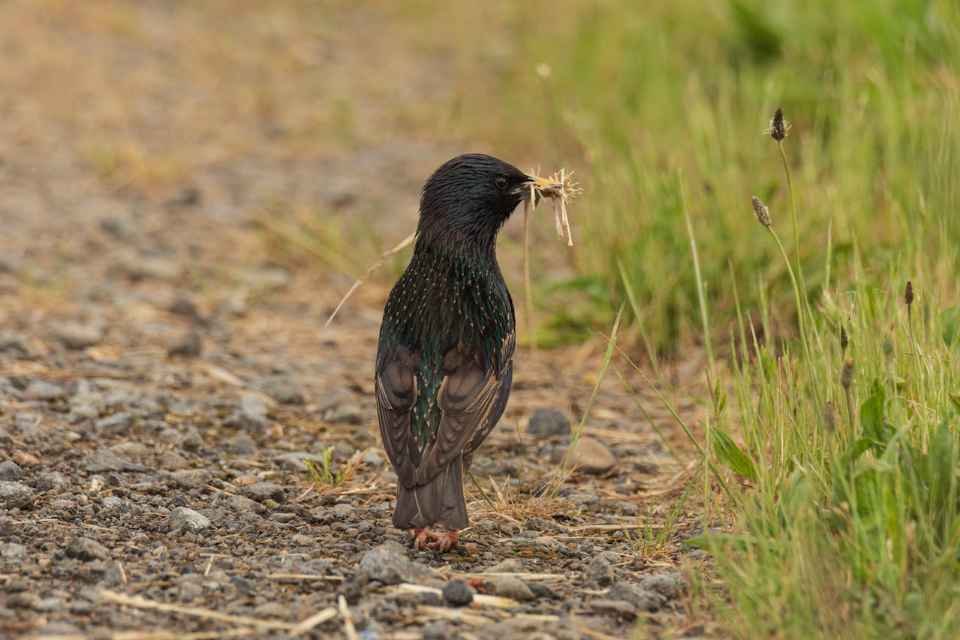Ever watched a massive black cloud swirl across the evening sky, only to realize it’s actually thousands of birds moving in perfect synchronization? 😮 Yeah, those are European starlings, and they’re probably the most underappreciated performers in the avian world. If you’ve ever been curious about the characteristics of European starlings, you’re in the right place.
I’ll never forget the first time I witnessed a proper starling murmuration, it was like watching nature’s version of a Flash Mob, except way cooler and with better choreography.
These glossy black birds with their punk-rock attitudes have conquered North America so thoroughly that most people assume they’ve always been here. Spoiler alert: they haven’t. But boy, have they made themselves at home! From their incredible vocal abilities to their controversial reputation as invasive species, European starlings are fascinating creatures that deserve more credit than they typically get.
Physical Characteristics and Identification
Distinctive Plumage and Seasonal Changes
European starlings are basically the chameleons of the bird world when it comes to their appearance. During breeding season, these birds sport glossy black plumage with an iridescent sheen that flashes green and purple in the sunlight. Their bills turn bright yellow, giving them a somewhat regal appearance that contrasts beautifully with their dark feathers. According to the Cornell Lab of Ornithology, this seasonal bill color change is a reliable field mark for identifying starlings in breeding condition.
But here’s where it gets interesting – winter plumage tells a completely different story. The same birds that looked sleek and sophisticated in summer become speckled with white and buff-colored spots, creating a starry pattern that actually gave them their name. It’s like they switch from formal wear to polka dots for the colder months.
Juvenile starlings look nothing like their parents, which can confuse beginning birdwatchers. Young birds are brown and streaky, resembling oversized sparrows more than the glossy adults they’ll become. I remember spending ages trying to identify what I thought was some rare brown bird, only to discover it was just a teenage starling going through its awkward phase.
Size and Build Characteristics
These birds are medium-sized members of the passerine family, typically measuring about 8-9 inches in length with a wingspan reaching 15 inches. They’re stocky and compact, built more like little bulldozers than graceful songbirds. Their strong, pointed bills are perfectly designed for probing into soil and crevices, making them incredibly efficient foragers.
What really sets starlings apart physically is their walking gait. Unlike many birds that hop, starlings stride confidently across the ground with a swagger that suggests they own the place. And honestly, given their success as an introduced species, maybe they do.
Their wing shape is another distinctive feature – short and triangular, designed more for quick, agile flight than long-distance soaring. This build makes them incredibly maneuverable, which becomes obvious when you watch them perform their famous murmurations.
European Starling Behavior Patterns
Flocking and Murmuration Phenomena
The murmurations of European starlings are honestly one of nature’s most spectacular displays. These coordinated flight patterns can involve thousands, sometimes millions of birds moving as a single entity across the sky. The physics behind it is mind-blowing – each bird follows simple rules about staying close to neighbors and avoiding collisions, yet the result looks like choreographed artistry.
According to Favorite World Press, scientists reconstructed the movements of starlings flying in murmurations at speeds up to 20 m.p.h. Each bird follows its six or seven closest neighbors, reacting to direction changes in under 100 milliseconds. Studying over 3,000 murmurations across 23 European countries, researchers found these shifting flocks act as an anti-predator strategy, and the shapes they form mirror collective motion patterns seen in fish schools, wildebeest herds, and ant trails.
I’ve spent countless evenings watching these displays, and the timing is usually predictable. They typically occur during fall and winter months, about 30 minutes before sunset. The birds gather at communal roosts, creating these massive aerial ballets before settling down for the night. Ever wonder why they do this? It’s actually a survival strategy – predators have a much harder time targeting individual birds within a constantly shifting mass.
Safety in numbers extends beyond just predator avoidance. These large flocks also share information about food sources and roosting sites. When thousands of birds return to a roost each evening, they’re essentially creating a massive intelligence network. One bird’s discovery of a great feeding spot becomes everyone’s benefit.
Social Hierarchy and Communication
According to this study, European starlings maintain complex social structures within their flocks. Dominant birds typically feed first and choose prime roosting spots, while subordinate individuals wait their turn. This hierarchy shifts throughout the year, with breeding adults generally ranking higher than non-breeding birds and juveniles.
Their vocal communication is absolutely remarkable. Starlings can mimic other bird species, mechanical sounds, and even human speech with startling accuracy. I’ve heard individuals perfectly replicate car alarms, cell phone ringtones, and the calls of hawks so convincingly that other birds actually respond to the fake alarm calls.
Territorial behavior during breeding season reveals another side of starling personality. Males become aggressive defenders of their chosen nest sites, engaging in dramatic displays and physical confrontations with competitors. They’ll spread their wings, puff up their chest feathers, and emit harsh calls that sound more like threats than songs.
Diet and Foraging Behavior
Omnivorous Feeding Habits
European starlings are opportunistic omnivores with appetites that would impress any food critic. Their diet varies dramatically with season and availability, but they’ll eat almost anything from insects and worms to fruits and human food scraps. This dietary flexibility is one reason they’ve been so successful as an introduced species.
During spring and summer, protein-rich foods dominate their diet. They’re particularly effective at controlling pest insects – I’ve watched starlings methodically work through my lawn, pulling out grubs and caterpillars that would otherwise damage the grass. A single starling can consume hundreds of insects per day during breeding season.
According to the USDA’s APHIS program, European starlings are considered agricultural pests, causing an estimated $800 million in crop damage annually and contributing to disease spread. While they do eat insects, their overall impact on agriculture is harmful rather than beneficial.
In fall and early winter, starlings shift their diet toward fruits, seeds, and whatever human food sources they can access. They’re particularly fond of berries and late-season fruits, often raiding shrubs, hedgerows, and any remaining fruit before the harshest months. Once these sources are gone, they rely more on seeds, leftovers, and urban scraps.
This adaptability allows them to survive and thrive in colder months. Learn more about supporting birds during this time in Feeding Birds in Winter.
Foraging Techniques and Strategies
The probing behavior of starlings is fascinating to observe. They use their strong bills like tiny jackhammers, opening them while inserted into soil or bark to create larger holes for accessing hidden prey. This technique, called gaping, allows them to reach insects and larvae that other birds can’t access.
Group foraging amplifies their effectiveness. When starlings feed together, they create a systematic search pattern across an area, leaving virtually no stone unturned. I’ve watched flocks work through parks and lawns like organized cleaning crews, with birds leap-frogging over each other to ensure complete coverage of the feeding area.
Their urban adaptations are particularly impressive. Starlings have learned to follow lawn mowers to catch disturbed insects, open garbage bags for food scraps, and even learned the schedules of outdoor dining areas. They’re basically feathered entrepreneurs when it comes to finding food sources.
Nesting Habits and Reproductive Behavior
Nest Site Selection and Competition
European starlings are cavity nesters with absolutely no shame about stealing prime real estate from native birds. They prefer enclosed spaces like tree holes, building crevices, and nest boxes, but they’re not above evicting other species to claim these spots. This aggressive nesting behavior is one reason they’re considered problematic for native bird populations. In fact, they often compete directly with species like the Northern Flicker, which makes this rivalry especially interesting for birdwatchers.
Male starlings do the initial nest site selection and decoration. They’ll stuff potential cavities with twigs, grass, and various materials to create a foundation, then sing enthusiastically to attract females to inspect their handiwork. It’s like avian home staging, complete with curb appeal considerations..
The competition for nest sites can be intense. I’ve witnessed starlings engaging in serious battles over nest boxes, with multiple birds locked in aerial combat like tiny fighter pilots. They’ll also harass other cavity-nesting species, sometimes destroying eggs or killing nestlings to claim desirable locations.
According to a study on ResearchGate, European starlings are fierce competitors for nest sites, often usurping the cavities of other native species such as Northern Flickers, Red-bellied Woodpeckers, and Eastern Bluebirds.
Breeding Cycle and Parental Care
Breeding season typically begins in early spring, with peak activity occurring from April through July. Starlings are capable of producing multiple broods per year in favorable conditions, which contributes to their population success. Females lay 4-6 pale blue or greenish eggs, which both parents take turns incubating for about two weeks.
Parental duties are shared between male and female starlings. Both birds work tirelessly to feed their growing nestlings, making hundreds of feeding trips per day. They primarily bring insects and other protein-rich foods to support rapid chick development. Watching parent starlings during this period is exhausting – they’re basically running a 24-hour restaurant service.
Fledgling care continues even after young birds leave the nest. Parents will continue feeding and protecting their offspring for several weeks while teaching them essential survival skills. Family groups often remain together through the first winter, creating small flocks that eventually merge with larger congregations.
Nest Construction and Materials
Nest building reveals the creative side of starling behavior. They’ll incorporate almost anything into their structures – twigs, grass, feathers, paper, plastic, and even Christmas tinsel if it’s available. I once found a starling nest that looked like a craft store explosion, complete with colorful ribbons and shiny wrapper fragments.
The architecture is surprisingly sophisticated. Starlings create a cup-shaped structure within their chosen cavity, carefully weaving materials together to form a secure foundation. They’ll line the interior with fine materials like feathers and soft grasses to create a comfortable environment for eggs and nestlings.
Nest maintenance continues throughout the breeding season. Parents regularly add fresh materials and remove waste to keep the nest clean and comfortable. This attention to detail helps ensure high survival rates for their offspring and reduces the risk of parasites or diseases.
Ecological Impact and Conservation Status
Role in Ecosystem Dynamics
European starlings occupy a complex ecological niche in North American ecosystems. While they’re often vilified as invasive species, their impact isn’t entirely negative. They consume enormous quantities of agricultural pests, providing billions of dollars worth of natural pest control services annually.
However, their competition with native species for nesting sites and food resources creates genuine conservation concerns. Cavity-nesting birds like bluebirds, woodpeckers, and native wrens often lose out to aggressive starlings during breeding season. This competition pressure has contributed to population declines in some native species.
Agricultural interactions present a mixed bag of benefits and problems. While starlings control many crop pests, they also consume significant quantities of livestock feed and can damage fruit crops. Large flocks feeding in agricultural areas can cause substantial economic losses, particularly for small-scale farmers.
Population Trends and Distribution
European starlings (Sturnus vulgaris) were introduced to North America in the 1890s and have since become one of the continent’s most numerous bird species. However, their population has experienced significant fluctuations. According to Cornell CALS, the North American starling population declined from an estimated 166.2 million in 1970 to about 85 million birds. This decline has been consistent across various regions, although the degree varies.
Seasonal migrations further influence their distribution. Northern populations move south during winter, leading to large concentrations in warmer climates. These seasonal movements can strain local ecosystems and pose management challenges for wildlife authorities.
Urban environments have provided starlings with abundant resources, contributing to their success in human-modified habitats. They thrive in cities, suburbs, and agricultural areas, often reaching higher densities in developed regions than in natural habitats. This adaptability underscores the ongoing challenges for native wildlife conservation.
Conclusion
European starlings prove that success in the natural world often comes down to adaptability and attitude rather than beauty or popularity. These resourceful, intelligent birds have mastered the art of living alongside humans while maintaining their wild instincts and complex social behaviors.
Whether you love them for their incredible murmurations and pest control services or find their aggressive tendencies frustrating, there’s no denying that starlings have earned their place in North American ecosystems. Their behavioral complexity and ecological impact make them fascinating subjects for anyone interested in understanding how introduced species reshape natural communities.
FYI, the next time you see that swirling cloud of birds painting patterns across the evening sky, take a moment to appreciate the intelligence and coordination on display. European starlings might not be native, but they’ve certainly made themselves unforgettable residents of the neighborhood.

